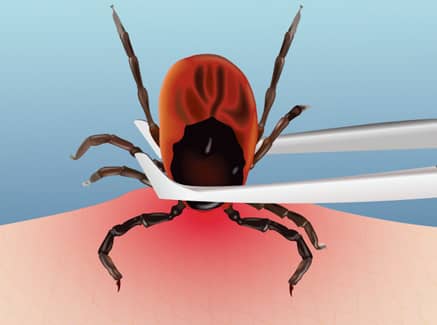This is How Mice Keep Getting Into Your Washington D.C. Home
01/30/2022
It is no fun finding a tick latched onto your skin; and with dangerous illnesses like Lyme disease affecting more than 300,000 people every year, there is even more reason to want to get rid of these tiny blood eaters. Here is a quick guide to protect yourself and your family from ticks, starting with the most important tip of all, "how to remove a tick."
 "How do I remove a tick?"
"How do I remove a tick?"There are many species of ticks in the United States, and this method will work best to remove them all. The trick to getting a tick off properly is to pinch it by the head--or as close to the head as possible. That means that you're going to want to get your tweezers or tick removal tool as close to the skin as possible.
Once you have the tick squeezed by the head, pull it out with a steady even pressure. Your goal is to get as much of its mouth parts out of your skin as possible.
You can also use floss to remove a tick, but it is not nearly as reliable as a set of tweezers or a tick removal tool. When using floss make sure you focus on getting a loop to tighten around the head of the tick. Then, pull away from the skin.
If you have a larger tick to remove and you're not near a set of tweezers, a tick removal tool, or floss, you can use a credit card from your wallet or pocketbook. Slide the credit card across the skin, under the body of the tick, and pry up on the tick. But be aware that this is not the best way to remove a tick. If you'll be back home within a 12 hour period, you can just wait to remove it then.
Once the tick has been removed, it is important to treat the area. You can use some isopropyl alcohol, iodine, or just soap and water.
You may want to save the tick in a jar of isopropyl alcohol, in case you want to get it properly identified. It will be important for your doctor to know whether or not you've been bitten by a deer tick (blacklegged tick) because these are the ticks that carry Lyme disease, and sometimes a tick bite from a deer tick doesn't have the signature bullseye rash associated with this disease.
This process works the same if you have an animal with a tick bite.

Many diseases ticks can transmit to humans and animals, like Lyme disease, can take 24-48 hours to transfer from the tick. Catching ticks early can prevent this disease. This is why it is important to always do checks when you come back in from being in the woods or grass. Routine tick checks can also help you discover what kind of tick bit you, so you can inform your doctor. Lyme disease can be treated in its early stage, but when misdiagnosed, it can pass the point where it can be treated.
There are three primary ticks in Virginia: the blacklegged tick (Lxodes scapularis), the American dog tick (Dermacentor variabilis), and the Lone Star tick (Amblyomma americanum). Only the blacklegged tick is a known carrier of Lyme disease.
Ticks can carry many diseases that, while not as serious as Lyme disease, can cause significant symptoms. According to the CDC, the following disease are linked to ticks: anaplasmosis, babesiosis, Borrelia mayonii, Borrelia miyamotoi, Colorado tick fever, ehrlichiosis, Heartland virus, Lyme disease, Powassan disease, rickettsia parkeri rickettsiosis, Rocky Mountain spotted fever, Southern tick-associated rash illness, Tickborne relapsing fever, tularemia, and 364D rickettsiosis.
The best way to prevent ticks is to understand how ticks get on people. They don't fall from trees, and they don't fly. These creatures climb to the top of a blade of grass and enter a pose referred to as questing. They hold their front leg up and cling to a passing host. When they do, they must then climb up until they find skin. For this reason, tucking pants into socks and wearing light clothing can help you see ticks before they bite you. Spraying insect repellent with 100% DEET on your shoes and pant legs can help as well. Avoid walking through tall grass and always check for ticks when you come back in from being in nature.
Another way to prevent ticks in your backyard is to put up a fence so that wildlife doesn't pass through your lawn and get a tick treatment from a professional pest control company.
If you live in our extensive service area of Northern Virginia, Maryland, and D.C., we can help you with that tick treatment. And, remember that when you get regular treatments for ticks, you'll also be killing disease-spreading mosquitoes on your property as well.
Mosquitoes and ticks thrive from spring to fall, which is why our Seasonal Mosquito Control plan is guaranteed to eliminate these yard pests during their peak. During the initial service, we will walk your property to identify where mosquitoes and ticks reside and breed and perform treatment to problem areas using a specialized misting system. Ongoing services continue once a month, typically March to October.
Monthly (7-8 Services Per Season)
Seasonal Coverage
Exterior Mosquito Treatment
Exterior Tick Spraying
Starting at $59*/month
*Some exclusions apply
For Faster Service Call Directly
(877) 282-1886Fill out the form and recieve feedback in less than 5 minutes. For immediate service please call.